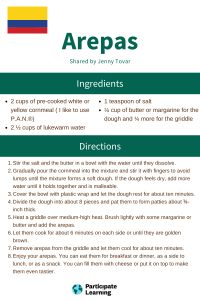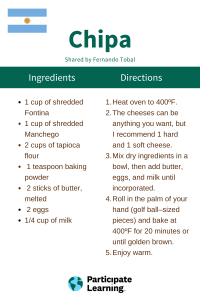Have you ever considered how the food we eat shapes our cultural identity? Many of us associate our favorite recipes with warm feelings and memories of home. During the holidays, our appreciation for and interest in food traditions peak as we gather with family and friends over meals. Cooking and eating together nourishes both body and spirit and is a tangible expression of the way we care for the people we love. Traditional recipes are carefully passed down from one generation to the next, and can also be an expression of cultural identity. Sharing those recipes can be a source of pride and a simple way to celebrate one’s cultural heritage with others.
Celebrating Culture through Food
We understand culture using the metaphor of an iceberg. There is surface-level culture that is visible above the water level, but there is also a wealth of more nuanced culture that lies below the surface. Food is considered a surface-level element of culture because it is a tangible and very visible element that can be tied to a cultural group or region. To understand the traditions and significance behind the foods we eat and why we make them is to gain a deeper appreciation of the role food plays in helping us relate to our cultural identities. Have you ever tried a new cuisine and been inspired to use that experience as an entry point to exploring the food culture of that region? Conversely, when we move or travel to a new place, a home-cooked meal can often be a source of comfort and stability while keeping us in touch with our roots.
Food Culture in Your Classroom
As an international educator, sharing food and recipes with students offers you a delicious and exciting way to weave together history, culture, and love, all while sharing your cultural heritage. Help your students learn and appreciate other people’s cultures by sharing a favorite recipe and its significance. You can also invite students to share recipes from their families and celebrate all of the unique traditions and cultures in your classrooms! In the spirit of sharing food culture and traditions, read below for several recipes and favorite memories from ambassador teachers and Participate Learning staff.
Arepas from Colombia with Jenny
For me, cooking arepas is a trip to my country and my childhood. It brings so many memories such as the sweet smell of the kitchen while cooking them in the griddle as we played around with my brother or talked about school and everyday life with my mom. It is also the way I remain connected to my culture and my traditions and how I share a piece of what is significant and meaningful to me with new friends. Cooking arepas also allows me to be creative by incorporating local ingredients into them or improvising by adding new combinations in different dishes. For me, cooking arepas here has been a way to feel at home in a new home.

Chipa Bread from Argentina with Fernando
Getting together with family and friends at someone’s home to enjoy an asado, empanadas, and food in general is common every weekend in Argentina. Argentinian culture revolves around friends and food. I enjoy continuing this tradition for my family and friends.
For me, chipas bring back memories of when I lived in Resistencia, a city in northeastern Argentina, as this is more commonly eaten in this part of the country. When we walked to school, we usually passed a bakery where you could smell the warm cheesiness from a block away! They are especially delicious when they are hot from the oven.

At Participate Learning, we are committed to creating global, cultural, and language connections that empower students and educators to positively impact the world. Our ambassador teachers strengthen student outcomes, promote cultural understanding, and play a meaningful role in cultivating global leaders who create a more peaceful world. Read how other ambassador teachers are organizing school-wide cultural celebrations here, or learn more about the impact of cultural exchange here.




